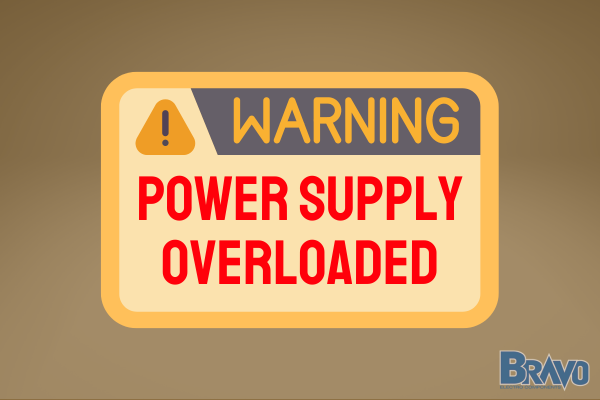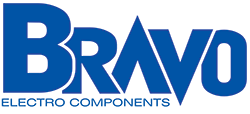
An overloaded power supply compromises your operation’s safety and efficiency. Overloading can lead to serious short-term and long-term issues, posing risks to connected devices and the overall stability of your system.
Avoiding these problems requires an in-depth understanding of how to tell if my power supply is overloaded. So, what are the overloaded power supply symptoms you should watch out for - and what happens when you overload a power supply, exactly?
This issue manifests through symptoms like unusual buzzing or humming noises, excessive heat, odd smells, and system instability. Recognizing these signs early is key to preventing potential damage.
We'll cover all these symptoms and provide expert tips on how to respond effectively, from immediate steps to reduce the load to long-term solutions for system stability.
We're here to help you identify issues and offer solutions to ensure your power supply is not just efficient but also safe and dependable. If you discover you need a power supply replacement, you can trust our selection from the top power supply manufacturers!
What is DC Power Supply Overload?
DC power supply overload occurs when the power demand from connected devices exceeds the supply's capacity to deliver power safely and efficiently. Essentially, it means that the power supply is being asked to provide more electricity than it is designed to handle.
This overburdening can lead to various problems, such as overheating, voltage drops, and in severe cases, power supply failure. Understanding and avoiding overloading is crucial for maintaining the health and safety of both the power supply and the devices it powers.
So, let’s talk about how to tell if my power supply is overloaded by breaking down the most prominent overloaded power supply symptoms to keep an eye out for.
How to Tell if My Power Supply is Overloaded: Overloaded Power Supply Symptoms to Watch Out for
Noticing bad power supply symptoms like those of an overloaded power supply is critical to protecting your investment in the unit itself along with connected devices.
So, let’s walk you through power supply troubleshooting and discuss how to tell if my power supply is overloaded.
Unusual Noises: Buzzing or Humming
Buzzing or humming noises from a power supply can signify DC power supply overload. These sounds may result from components like transformers or inductors vibrating under excessive electrical stress.
High-frequency whining, often known as 'coil whine,' can occur when the power supply operates beyond its standard capacity.
Excessive Heat and Odd Smells
Overloaded power supplies tend to overheat. If the unit feels abnormally hot to the touch or if there’s an increase in the temperature around the power supply area, it's a clear warning sign.
Overheating can sometimes be accompanied by unusual smells, like burning or an electrical scent. These odors indicate that components within the power supply may be overheating to the point of damage.
System Instability and Performance Issues
An overloaded power supply can lead to system instability. This might manifest as random system crashes, reboots, or failure to start.
Performance issues, such as the inability to run high-demand applications or hardware, can also indicate that the power supply is unable to meet the system’s power requirements.
Technical Indicators of Power Supply Overload
Power supply voltage fluctuations are a technical indicator of an overloaded power supply. Tools like a multimeter can be used to check for consistent voltage output. You can learn more about what causes a voltage drop in our blog.
Power supplies often have built-in diagnostic LEDs or software interfaces that can indicate stress or failure, which can be a sign of overload.
What Happens When You Overload a Power Supply?
You know what causes it…but what happens when you overload a power supply?
An overloaded power supply leads to a range of consequences that can have both immediate and long-lasting effects on the system and its components. To help you grasp the gravity of this issue, here are a few short and long-term risks.
Short-Term Consequences
DC power supply overload typically generates excessive heat. As the internal components, especially transformers and capacitors, struggle under the increased load, they heat up.
This overheating can trigger safety mechanisms, causing the power supply to shut down abruptly to prevent damage.
An overloaded PSU can't maintain a stable voltage output. This leads to voltage drops or spikes, which can directly impact the performance of connected devices, causing them to malfunction or shut down.
Long-Term Consequences
Continuous overloading can stress the PSU’s components, accelerating their wear and tear. This is particularly detrimental to capacitors, which can swell or leak under prolonged stress, leading to eventual failure.
In other words, you won’t maximize your power supply lifespan. This is due to the cumulative effect of heat and stress on its internal components.
Risks to Connected Devices and Systems
The risks of an overloaded power supply aren’t limited to the unit itself. Connected devices, systems, and your operation’s safety/efficiency are put in peril as well:
- Hardware Damage and Failure: Overloading can lead to unstable power output, which can be particularly damaging to sensitive industrial equipment. This instability can cause malfunctions in intricate systems like manufacturing machinery, medical devices, or robotic equipment, potentially leading to expensive downtime and repairs.
- Data Corruption and Loss: In systems where data integrity is crucial, such as in medical recordkeeping or industrial automation, power instability due to an overloaded PSU can result in data corruption or loss. This could have far-reaching consequences, affecting operational efficiency and accuracy.
- Safety Hazards: Overloading a PSU in a high-stakes industrial environment can create significant safety hazards. The excess heat generated can pose fire risks, especially in environments with flammable materials or in tightly packed facilities. Additionally, the failure of safety-critical systems due to power issues can put workers and equipment at risk.
All things considered, this is not an issue you can afford to overlook. So, let’s talk about what to do if your power supply is overloaded.
What to Do if Your Power Supply is Overloaded
If you suspect you’re dealing with DC power supply overload, it's crucial to take immediate and long-term steps to address the issue. Here’s how can you avoid the risks we’ve discussed above…
Immediate Steps to Reduce Load
Evaluate the devices connected to the power supply. Identify which devices are crucial and which can be temporarily disconnected to alleviate the load. This prioritization helps prevent the immediate risk of overloading.
An overloaded power supply can sometimes be due to a faulty device drawing more power than normal. Check each connected device for any signs of malfunction or unusual power draw.
Long-Term Solutions for System Stability
Review your entire power setup. Consider the wattage each device requires and calculate the total power needed. Our guide on how to check PSU wattage can assist with this step. Remember to factor in additional headroom for peak usage.
If your total power requirement exceeds the current power supply's capacity, it's time to consider an upgrade. Choose a power supply with a higher wattage rating than your total need to ensure reliable performance under all conditions.
Addressing Inrush Current Overloading PSU
When electronic equipment is powered on, it can draw a large amount of current initially, known as inrush current. This surge can overload the power supply, especially if multiple devices start simultaneously.
Using MEAN WELL’s ICL-16 Inrush Current Limiter helps manage the inrush current, particularly in systems with multiple power supplies. It’s a great means of power supply overload protection.
The ICL-16 effectively reduces the initial surge of current, preventing the circuit breaker from tripping falsely. It's particularly beneficial in setups with capacitive loads and can allow for the installation of several power supplies on the same AC line without overloading each unit.
You gain access to this intuitive MEAN WELL device here at Bravo Electro. And if you’re still unsure about what power supply you need, don’t hesitate to reach out to our experts here for personalized guidance and recommendations.
As the trusted choice for all power supply types, you can rest assured we’ve got the expertise and solutions you need for reliability and efficiency. Find the right replacement below:
We also have tips on installing a new power supply to accommodate your necessary load if you decide to go the replacement route. Before we wrap up this guide on how to tell if my power supply is overloaded, let’s highlight a few preventative measures you can implement going forward.
Preventive Measures to Avoid DC Power Supply Overload Going Forward
Now that you know what happens when you overload a power supply, let’s talk about how you can eliminate these concerns. You can avoid dealing with the overloaded power supply symptoms in the future by choosing the correct PSU for your unique needs and conducting routine maintenance.
Proper Sizing and Specification Matching
As we said earlier, you should accurately calculate the total power requirement of all connected devices. Consider peak power consumption, not just average use. From there, you can choose the right power supply size. You should also look for a unit with power supply overload protection.
It’s important that you think about scalability as well, as what you need today may differ from what you need a year from now. You don’t want to have to come back and replace the unit prematurely as you outgrow it.
Ensure that the power supply’s voltage and current specifications align with your system’s requirements. We have more resources on navigating power supply specifications, power supply efficiency rating, power supply certification, power supply topology, power supply connector types, and more power supply ratings in our blog.
Importance of Regular Maintenance and Upgrades
Regularly inspect your power supply for signs of wear, overheating, or damage. This can include visual checks and monitoring performance indicators.
Keep the power supply and its environment clean. Dust accumulation can impede cooling and lead to overheating.
Be proactive in upgrading your power supply if your power needs increase or if the unit shows signs of aging or inefficiency. Upgrades are essential to keep up with the evolving power demands of modern equipment.
Closing Thoughts on How to Tell if My Power Supply is Overloaded
Identifying and addressing an overloaded power supply is crucial for the health and efficiency of your systems. You should now feel confident in how to tell if my power supply is overloaded.
Symptoms like unusual noises, excessive heat, and system instability can indicate overload. Regular maintenance, proper sizing, and upgrading your power supply are essential preventive measures for power supply overload protection.
Remember, a power supply that matches your system's needs not only ensures stable operation but also safeguards against potential damage. Now that you know what happens when you overload a power supply and what you can do to prevent it, it’s time we wrapped this conversation up.
Want to learn more about the world of power? Our blog has resources on topics like how to fix power supply, types of DC-DC converter, is household electricity AC or DC, how to convert DC to AC, difference between AC and DC power, DC-DC converter efficiency, linear power supply vs switching power supply, power supply redundancy, what is an AC adapter, and more.
Whether you need a 12v power supply, 24v power supply, or 48v power supply, or even high-voltage power supplies, Bravo Electro is just a click or call away ready to help.
We’ve curated the top models from the most respected brands in the industry. And, we back them up with world-class customer support every step of the way.
So what are you waiting for? Address the overloaded power supply symptoms with our advice and products at Bravo Electro today!

